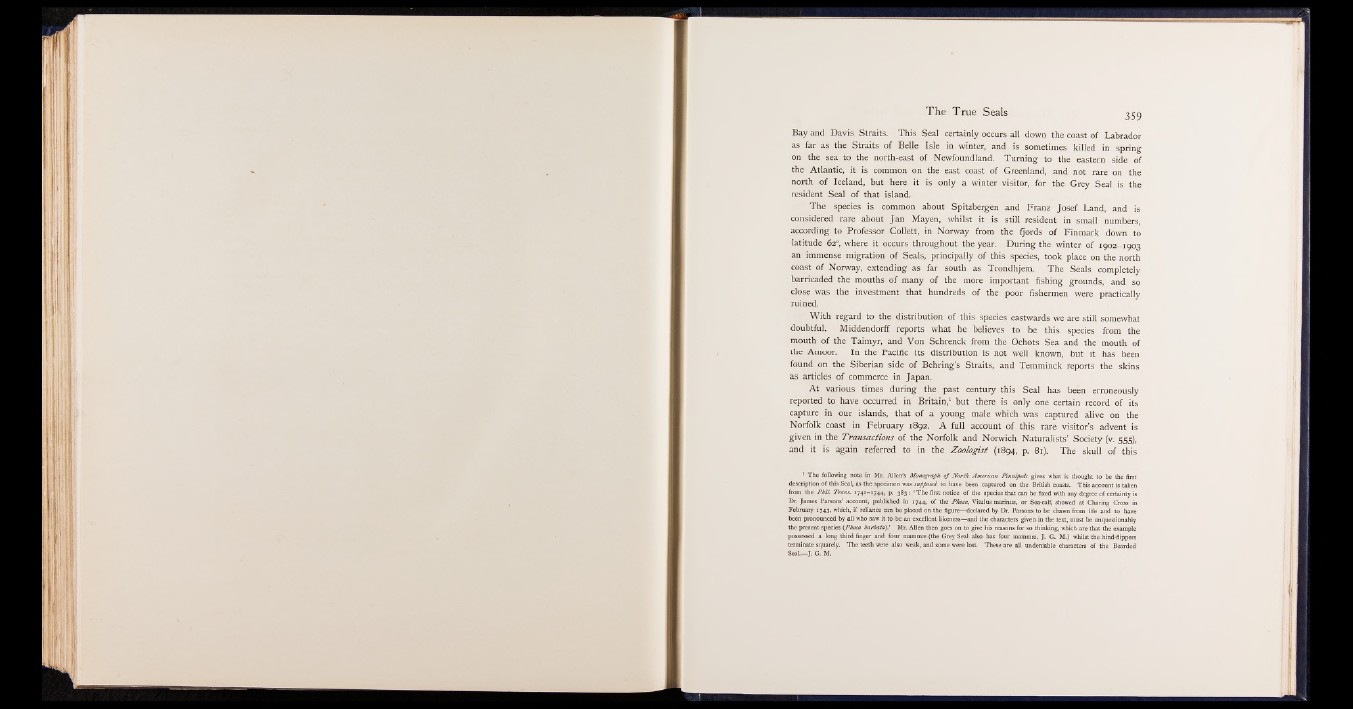
The True Seals 3 5 9
Bay and Davis Straits. This Seal certainly occurs all down the coast of Labrador
as far as the Straits of Belle Isle in winter, and is sometimes killed in spring
on the sea to the north-east of Newfoundland. Turning to the eastern side of
the Atlantic, it is common on the east coast of Greenland, and not rare on the
north of Iceland, but here it is only a winter visitor, for the Grey Seal is the
resident Seal of that island.
The species is common about Spitzbergen and Franz Josef Land, and is
considered rare about Jan Mayen, whilst it is still resident in small numbers,
according to Professor Collett, in Norway from the fjords of Finmark down to
latitude 62°, where it occurs throughout the year. During the winter of 1902-1903
an immense migration of Seals, principally of this species, took place on the north
coast of Norway, extending as far south as Trondhjem. The Seals completely
barricaded the mouths of many of the more important fishing grounds, and so
close was the investment that hundreds of the poor fishermen were practically
ruined.
With regard to the distribution of this species eastwards we are still somewhat
doubtful. Middendorff reports what he believes to be this species from the
mouth of the Taimyr, and Von Schrenck from the Ochots Sea and the mouth of
the Amoor. In the Pacific its distribution is not well known, but it has been
found on the Siberian side of Behring’s Straits, and Temminck reports the skins
as articles of commerce in Japan.
At various times during the past century this Seal has been erroneously
reported to have occurred in Britain,1 but there is only one certain record of its
capture in our islands, that of a young male which was captured alive on the
Norfolk coast in February 1892. A full account of this rare visitor’s advent is
given in the Transactions of the Norfolk and Norwich Naturalists’ Society (v. 555),
and it is again referred to in the Zoologist (1894, p. 81). The skull of this
1 The following note in Mr. Allen’s Monograph o f North American Pinnipeds gives what is thought to be the first
description o f this Seal, as the specimen was supposed to have been captured on the British coasts. This account is taken
from the P hil. Trans. 1742-1744, p. 383: ‘ The first notice of the species that can be fixed with any degree of certainty is
Dr. James Parsons’ account, published in 1744, of the Phoca, Vitulus marinus, or Sea-calf, showed at Charing Cross in
February 1743, which, if reliance can be placed on the figure—declared by Dr. Parsons to be drawn from life and to have
been pronounced by all who saw it to be an excellent likeness— and the characters given in the text, must be unquestionably
the present species (Phoca barba/a).’ Mr. Allen then goes on to give his reasons for so thinking, which are that the example
possessed a long third finger and four mammae (the Grey Seal also has four mammae, J. G. M.) whilst the hind-flippers
terminate squarely. The teeth were also weak, and some were lost These are all undeniable characters of the Bearded
Seal.— J. G. M.